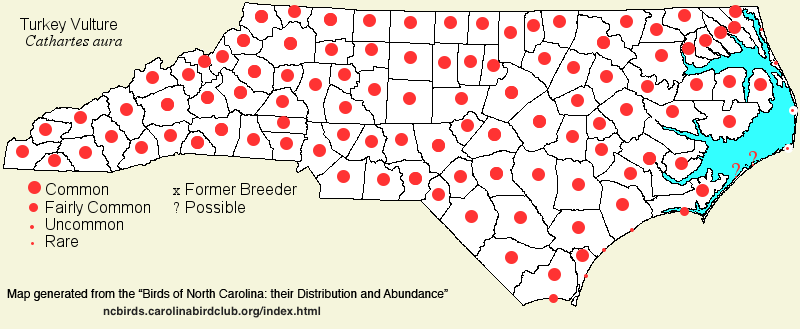 |  |
|
Turkey Vulture - Cathartes aura CATHARTIDAE Members: | Search Common: Search Scientific: |
|
|
|||||||
| General Comments | The Turkey Vulture is our most frequently seen "raptor" -- there is some question whether New World vultures are more closely aligned with storks than with hawks -- a common bird in all parts of the state, except on some coastal islands. Unlike with the Black Vulture, numbers of Turkey Vultures seem to have remained reasonably steady over the last 100 years, and as it feeds on smaller carcasses (such as a squirrel), it has not been impacted by declines and failures of large-scale livestock operations. The species nests in similar sites as does the Black Vulture -- abandoned sheds/barns, nooks in cliffs, hollow trees, under dense thickets -- but it forages at all types of habitats, favoring open or broken country around wooded margins, fields, and other places wherever dead animals are found. Both species are also commonly seen feeding at landfills. | ||||||
| Breeding Status | Breeder | ||||||
| NC BRC List | Definitive | ||||||
| State Status | |||||||
| U.S. Status | |||||||
| State Rank | S5B,S5N | ||||||
| Global Rank | G5 | ||||||
| Coastal Plain | Permanent resident, though partially migratory. Common to very common (for a raptor) over nearly all of the province except along coastal islands, where scarce. Uncommon but increasingly seen on Hatteras and Ocracoke islands, and on Core Banks, in migration and early winter, but probably does not breed there. No obvious migration seen in the province, and not really more common in one season over another. Peak counts: | ||||||
| Piedmont | Permanent resident, though partially migratory. Common to at least locally very common (for a raptor) in most areas, though less numerous within a few miles of large cities. Perhaps slightly more numerous in winter than in summer. Peak count: 140, Pittsboro, 25 Nov 1983. | ||||||
| Mountains | Permanent resident, but with noticeable migratory movements. Common in lower elevations all year, but uncommon to rare in winter over about 4,500 feet. Noticeable fall migration, as detected at hawk watching sites. Peak counts: 482, Carvers Gap on Roan Mountain, 10 Nov 2017; 165, at a roost in Transylvania, 24 Sep 1985. | ||||||
| Finding Tips |
Except along the immediate coast, it is easily seen in the state, except on rainy or overly cloudy days. **** | ||||||
| Attribution | LeGrand[2018-02-20], LeGrand[2012-05-15], LeGrand[2011-11-26] | ||||||
| NC Map Map depicts all counties with a report (transient or resident) for the species. | Click on county for list of all known species. |
| NC Breeding Season Map Map depicts assumed breeding season abundance for the species. |  |